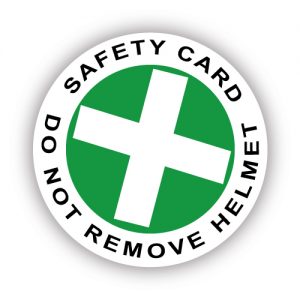 At last weekends – 2nd June 2013 – Downriders MCC charity ride out for the NSPCC – National Society for the Prevention of Cruelty to Children – we spotted some of the Biker NI Safety Card “Do Not Remove Helmet” stickers.
At last weekends – 2nd June 2013 – Downriders MCC charity ride out for the NSPCC – National Society for the Prevention of Cruelty to Children – we spotted some of the Biker NI Safety Card “Do Not Remove Helmet” stickers.
Downriders MCC say: “Thanks to everyone whom turned up today at the NSPCC ride out, some 220 bikers took to the roads on an enjoyable, run thanks to everyone of you who turned up!”
A fantastic day out at this annual with over £1,200 and counting raised for the NSPCC!
Check out the Downriders MCC on Facebook – Click Here
Now where can you spot your card!
The “Do Not Remove Helmet” Sticker
By placing the sticker on the right hand side of your helmet (NOT on the visor or other attachments) riders are alerting emergency responders that they carry a Biker NI Safety Card inside the lining of their helmet.
The wording on the sticker is aimed at passers by, lay people and good Samaritans, who may, in an attempt to help at the scene of a road traffic collision try and force a helmet off a rider’s head, the priority is not to get to the card.
Therefore the secondary purpose of the sticker is to keep the helmet in place until emergency responders assess the situation.
Remember removing a crash helmet safely is a skill which takes two people and requires specific training and practice.
The removal of a crash helmet takes into consideration head and neck (c-spine) injuries – unconscious/conscious casualty – breathing and maintaining open airways.
The wording on the sticker therefore should assist with the spinal management of the rider and keep the helmet in place until a professionally trained person can safely remove it.
Don’t ever attempt to remove another rider’s helmet on your own.
CRASH
One side of the card has the memory aid CRASH – take time to read it.
The person making the 999 call is the most important person at the scene because the information they give determines the response of the emergency services.
CRASH is intended to be a set of easy to remember steps to keep you or the other unfortunate rider safe, if either has been involved in a road traffic collision accident.
The card follows a similar set of questions universally used by ambulance service control centres, and focuses on safety, the location of the accident, and how serious it is.
Caution – don’t put yourself in danger
Road – what is your exact location?
Accident – involving how many vehicles?
Serious – is anyone unresponsive?
Help – don’t move the casualty, call 999
Information
The other side includes information about you used by the ambulance service and hospital:
Name: First and surnames are best, so please avoid nicknames.
Postcode:
DOB:(Date Of Birth)
House Number:
Allergies: List any Allergies you have.
Medication: List any medications you currently take.
Medical History: If you have had any operations in the last 12 months and/or suffer with a chronic illness e.g. diabetes, asthma, angina, etc.
Then, just put the card under the lining of your crash helmet because that’s where the crew will look for it.
Hopefully no-one will ever need to use the CRASH Card.However no matter how carefully you think of your safety, you may be in a situation where you or others can take advantage of the card.
Even if you’re fit and well a CRASH Card can improve your treatment pre hospital in the unfortunate event of an accident.
Collect It!
Complete It!
Keep It!

Leave a Comment